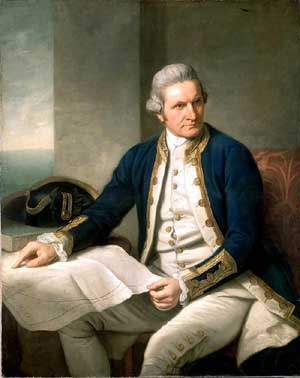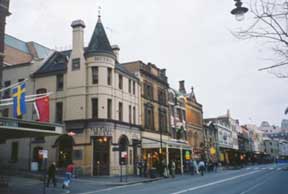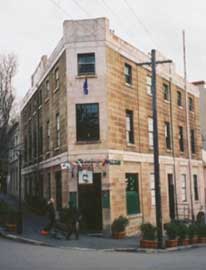Tales From Along the Wallaby Track No. 1079, Monday May 24, 2010
 Beer like rum is steeped in the history of Australia. Brewing started with Captain James Cook. That may come as a surprise but on August 1, 1768 as Cook was fitting out the Endeavour for its voyage to Australia Nathaniel Hulme wrote to Joseph Banks recommending he take “a quantity of Molasses and Turpentine, in order to brew Beer with, for your daily drink, when your Water becomes bad. Brewing Beer at sea will be peculiarly useful in case you should have stinking water on board; for I find by Experience that the smell of stinking water will be entirely destroyed by the process of fermentation” (the capital letters are as written by Hulme).
Beer like rum is steeped in the history of Australia. Brewing started with Captain James Cook. That may come as a surprise but on August 1, 1768 as Cook was fitting out the Endeavour for its voyage to Australia Nathaniel Hulme wrote to Joseph Banks recommending he take “a quantity of Molasses and Turpentine, in order to brew Beer with, for your daily drink, when your Water becomes bad. Brewing Beer at sea will be peculiarly useful in case you should have stinking water on board; for I find by Experience that the smell of stinking water will be entirely destroyed by the process of fermentation” (the capital letters are as written by Hulme).

On August 26, 1768 the Endeavour sailed from England. Captain Cook, who believed beer maintained the health of his seamen, wrote in his journal there were four tonnes of beer on board. He also noted by September 1768, barely a month later, the beer had almost gone. He noted in his journal “served wine to the ship’s company, the Beer being all expended to two casks which I wanted to keep for some time longer”.
Captain James Cook had the distinction of putting down the first brew in Oceania on March 27, 1773.
Drinking alcohol in Australia has been part of our culture since the first barrels of rum rolled off the decks of the First Fleet. Rum or “grog” as it was known was the national currency. In the early days the population was said to be divided into two classes, those who sold rum and those who drank it.
Drunkenness
In 1802 when Dr. Redfern, the Colonial Surgeon, arrived in the Colony he wrote: ‘it was lamentable to behold the excess to which drunkenness was carried. It was no uncommon experience for men to sit around a bucket of spirits and drink it with quart pots until they were unable to stir from the spot’.
In his book For the Term of his Natural Life (1867) Marcus Clarke was scathing of the period: ‘Drunkenness was a prevailing vice. Even children were to be seen in the streets intoxicated. On Sundays, men and women might be observed standing round the public-house doors, waiting for the expiration of the hours of public worship in order to continue their carousing. As for the condition of the prison population, that indeed is indescribable. Notwithstanding the severe punishment for sly grog selling, it was carried on to a large extent. Men and women were found intoxicated together, a bottle of brandy was considered to be cheaply bought for 20 lashes. All that the vilest and most bestial of human creatures could invent and practise was in this unhappy country invented and practised without restraint and without shame’.
As early as 1802 Lord Hobart concerned at the consumption of rum, wrote on August 29 to Governor Philip King: ‘The introduction of beer into general use among the inhabitants would certainly lessen the consumption of spirituous liquors. I have therefore in conformity with your suggestion taken measures for furnishing the Colony with a supply of ten tons of Porter, six bags of hops, and two complete sets of brewing material’.
It was official at last! By the mid 19th century it was clear beer was to be Australia’s national drink.
Early Brewers
Even though rum was the currency for most things no doubt there were attempts to brew beer from the early days. The first recorded details of brewing were by a Mr John Boston, a free settler, who arrived in Sydney in 1794.

It must have been an interesting brew if reports of its main ingredients are correct. With the aid of an encyclopaedia Boston found he could make beer from Indian corn (maize), and for bittering it he used the leaves and stalks of the Cape gooseberry plant. It was a poor product even though he had erected at some expense a building proper for the business but production soon ceased. In the same year the first brewery was established at Kissing Point.
John Boston was a young man with radical ideas. He tried his hand at making salt at Bennelong point, then at making soap. Both ventures failed. He was granted 170 acres at Mulgrave Place and built a windmill. Despite this, in June 1797 Governor Hunter had come to the conclusion Boston was ‘one of those whom the Colony will not derive any advantage from’. He became a trader and bought a ship with Simeon Lord. He was last heard of on September 30, 1804 when he was killed by Tongans at Nukualofa.

Successive Governors encouraged both the establishment of breweries and attempts to produce the basic raw materials of malt and hops. The aim was to break the prevailing habit of drinking rum and the “Rum Currency” which dominated the economy.
The first and last Government Brewery, established in Parramatta in 1804 and operated by experienced brewers, marked the start of the industry in Australia. However, this was a financial failure and was bought by the Government brewer, Thomas Rushton, in 1808.
On December 23, 1804 a rival brewery was established by Mr P. Larken who placed the following advertisement in the Sydney Gazette: ‘Larken’s Brewery, Ales—Pale, Brown and Amber; Twopenny and London Porter, etc, prepared after the system of British Breweries. The advertiser respectfully hopes that the general introduction of these wholesome, long and justly celebrated English beverages, as tending to supersede the too destructive use of ardent spirits, will recommend the present undertaking to the attention of the Colony from its prompt conduciveness to health, sobriety, and economy’.
Pubs
If you brew beer you need a pub. In 1796 Australia’s first legal pub, the Masons Arms, was built in Parramatta by James Larra or Lara a Frenchman, who was deported from London for stealing a tankard.
Settlers were encouraged to grow barley and to trade it for beer. Incidentally hops was first grown in Australia by James Squire in 1804. This achievement did not go unrecognised. The Government Gazette dated March 16, 1806 records he was awarded a cow from the Governor’s herd for his efforts.
As Sydney’s oldest pub in the Rocks area the Fortune of War built for Samuel Terry dates back as far as 1801. The first recorded liquor license for the premises was received in 1828 by John Boreham. Since then the Fortune of War has survived changes in ownership, the bubonic plague, natural disasters and wars. The original fabric can still be seen inside.
This historic pub had a reputation as a popular “first and last stop ashore” for troops of the armed forces who would experience the “fortunes of war’ when they departed.

The reputation of the Rocks as a rowdy district began early in the 19th century. Numerous pubs—The Brown Bear, Cat and Fiddle, Jolly Sailor, Rose of Australia, World Turned Upside Down, and the Whaler’s Arms and other inns of sins are long gone but the Hero of Waterloo still functions. Built in 1843 by convict labour the pub bears testimony to its past with iron shackles in its cellar walls. This is where drunken mariners were kidnapped and taken through a secret tunnel below to be used as forced labour on clipper ships.
Over the years Mudgee has had its share of shanties, inns, taverns, and bush pubs. The first known hotel was the Mudgee Hotel built by Steve Tuckerman in 1832 for William Blackman and stood opposite the Court House in Market Street. In 1869 it was demolished and replaced by the present Court House Hotel. Other early hotels are the Paragon, Lawson Park and Oriental.
Mudgee now has it own commercial brewery once again. Local beer is back! Did it ever disappear? Not so according to local connoisseur “home brewers” who held the fort. Long gone are the days when makeshift ingredients like Indian corn and Cape gooseberry leaves were used. A quick trip to a supermarket for their ingredients produces a great beer with flavour and the right “head”—so I am told.
My last beer was tasted in 1995 on an autumn Sunday afternoon in a tiny heritage pub in Koln, Germany, with local friends who were introducing me to German beer, black bread and local cheeses.
Cheers!

You must be logged in to post a comment.